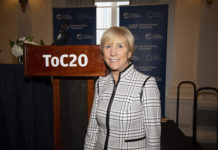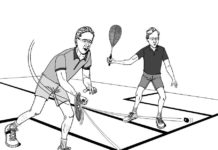By Jeannie Blasberg
This question nags at me. It appears that most women drop out of the ranks of competitive squash at a greater rate than men—the question I struggle with is why? Women make up less than 20% of our adult squash playing population even though they represent nearly 40% of college players. This phenomenon was especially poignant earlier this season as women around the country scrambled to form teams of five for the national Howe Cup competition, held in Baltimore at the end of October.
Organizing a women’s squash event requires serious lead-time. With kids, jobs, and spouses etc, there is a lot of logistical planning and coverage that needs to take place.
In helping recruit Boston’s teams this year, I encountered a host of obstacles—several regular players had ventured into grad school—they couldn’t afford to miss Friday classes, other women were only months postpartum, still pregnant, or just not able to escape the demands of very small children. Some were injured (can’t argue with that), and some due to budget constraints could not swing the expense (ok so we’ll sleep four to a room). Some historically reliable cities failed to field a team at all.
Howe Cup brings the scarcity issue into the spotlight—but it exists all year long. Why is adult female participation in tournaments and leagues so low? And there is a ripple effect—not only does this impact the average club player, but ultimately the ranks of women competing for the top spots on our National Teams is much smaller than we would hope. So where do the women go?
One hypothesis is that a lack of time (make that time and money) is at the root of the problem. It is a real time commitment to keep up the fitness necessary for squash and it is expensive to live and play in most cities. Another hypothesis is gender related—do many women shy away from one-on-one competition in favor of other fitness options? A third, regrettable hypothesis is that parental pressure on the junior “scene” and/or a demanding college squash regimen burn young women out, never to be seen or heard from again. These are just a few of the possibilities gathered over the years through discussions considering this phenomenon.
US Squash is serious about this alarming trend and would like to understand this issue better. We have established a Task Force (*members indicated below) to do research and propose some actions aimed at keeping young women in the game and bringing others back. Would lower cost club memberships for people in their early twenties help? If babysitting were offered at National Tournaments, would parents use it?
The goal is to keep women in the game during their young adult years despite various obstacles. Now in my forties (gasp), I can attest that it is well worth keeping the squash flame alive through all the demands of young adulthood and parenthood—it gets better with age, it is an amazing antidote for stress, and it is the passport to lifelong friendships and experiences.
If you can relate to any of the scenarios in this column please write. If you have successfully overcome challenges in order to stay in the game please let us know how you made it work. Or, if you haven’t been able to play or have friends, daughters, or wives who don’t play anymore—please pass those stories along as well. Send your stories or ideas to chairperson@us-squash.org.
* Women’s Task Force: Peg Wyant (Chair), Jeannie Blasberg, Libby Welch, Shona Kerr, Lulu Chou, Ann Watson, Marcia Salovitz and Amy Milanek.





